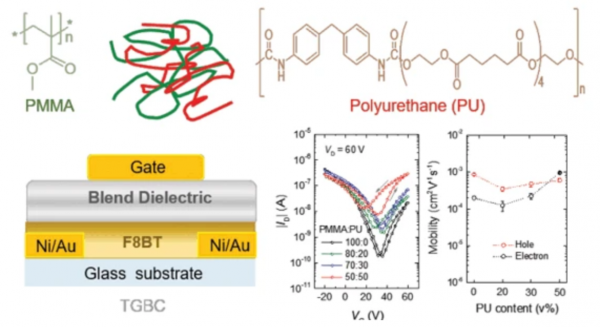Improved Electron Transport in Ambipolar Organic Field-Effect Transistors with PMMA/Polyurethane Blend Dielectrics
- 저자
- Grace Dansoa Tabi, Benjamin Nketia-Yawson*, Jea Woong Jo, Yong-Young Noh*
- 저널명
- Macromolecular Research, 28, 1248-1252 (2021)
- 년도
- 2021
- Link
- https://doi.org/10.1007/s13233-020-8161-6 478회 연결
[Abstract]
We report improved electron transport in solution-processed ambipolar organic field-effect transistors (OFETs) employing polymer dielectric blends of low-k poly(methyl methacrylate) (PMMA) and polyurethane (PU) elastomer. Ambipolar poly(9,9-dioctylfluorene-alt-benzothiadiazole) (F8BT) OFETs typically showed an unbalanced hole and electron mobilities of 8.7 ± 0.4 × 10−4 and 2.0±0.1 × 10−4cm2V−1V−1 respectively, using neat PMMA gate dielectric. By controlling the blending ratio of PU (0∼50 v%) in the PMMA-PU blend dielectrics, we tuned the charge carrier transport in the F8BT OFETs. The electron mobility gradually increases significantly, resulting in nearly perfect ambipolar characteristics with hole and electron mobilities of 6.0 ± 0.7 × 10−4 and 9.7 ± 0.4 × 10−4 cm2V−1V−1 respectively in PMMA: PU blend of 50:50 v%. The remarkable trend ensues from trapping of hole carriers at the dielectric/semiconductor by the -N-H- and carbonyl group (C=O) interface dipoles in the PU dielectric. The PMMA-PU blend dielectrics demonstrate excellent potentials for high-performance ambipolar OFETs, inverters, and complementary circuits.
